BY DASHIELL ALLEN | Once a bustling and vital artery leading from the Brooklyn Bridge into Chinatown and the Lower East Side, Park Row has remained under a state of pseudo-militarized lockdown ever since the terrorist attacks of 9/11. Delivery trucks are subject to bomb-sniffing dogs.
While pedestrian and bicycle traffic are technically permitted, it feels almost as if one were breaking the law by walking down this street, passing countless police checkpoints and roadblocks. Barricades are haphazardly strewn along the sidewalk where the street merges into the Bowery, almost as if someone had forgotten to put them away after a parade took place.
Residents of Chatham Green, a massive apartment complex bordering Park Row, must show ID to New York Police Department officers before parking their cars.
Many Lower Manhattan residents may recall weaving their way through checkpoints like these in the months following the attack on the Twin Towers. In virtually all other communities the barriers have been removed and life has continued on — except for Park Row and surrounding streets, which border the N.Y.P.D.’s central headquarters, One Police Plaza.
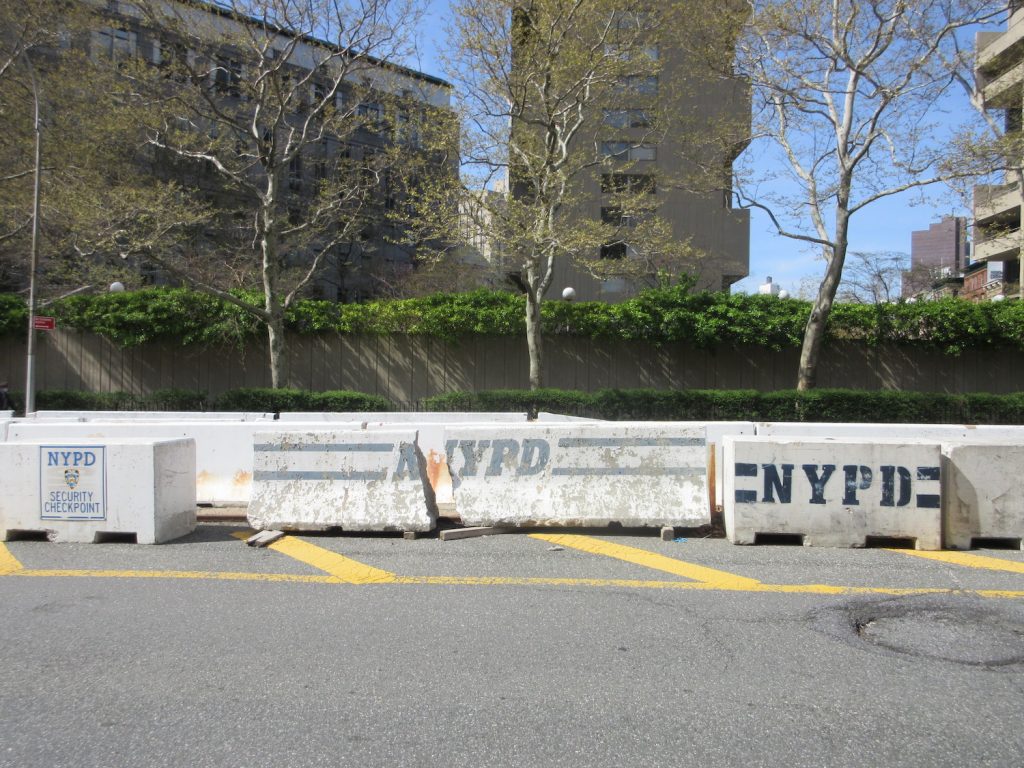
The police have said in the past that all of the barriers are part of antiterrorism measures. But the community is less than convinced.
Chinatown residents and community leaders have spent nearly the past 20 years advocating, to varying degrees of success, for the streets, in the area collectively referred to as the Civic Center, to be reopened, or at the very least revitalized. Now, as the state prepares to make a $20 million investment in the neighborhood’s recovery from COVID-19 and with a new councilmember in office, advocates have renewed hope.
Nancy Kong, a nearly 20-year resident of Chatham Towers and co-founder of the Park Row Alliance, believes this once-vital artery has the potential to be reimagined as the “southern gateway to Chinatown.” She points out that Park Row lies at the confluence of a myriad of communities, with “old” Chinatown to the northwest, “new” Chinatown along East Broadway, Tribeca to the west and Little Italy to the north.
“I think the city forgot as they built up the Civic Center that the neighborhoods were here first, and that people lived here,” she said. “And that’s what we’re fighting for, it’s just to make this livable again, and to coexist together.”
“This is a residential neighborhood. It’s just incredible that they have no feeling for us, they have no feeling that people are alive and live here,” said Joseph Mirabella, 77, who has lived in Chatham Towers since 1972, around when the construction of One Police Plaza was completed. “It’s the concept that as a human shield, we are the moat in front of the castle that protects the police — and we’re not afraid, but they are.”
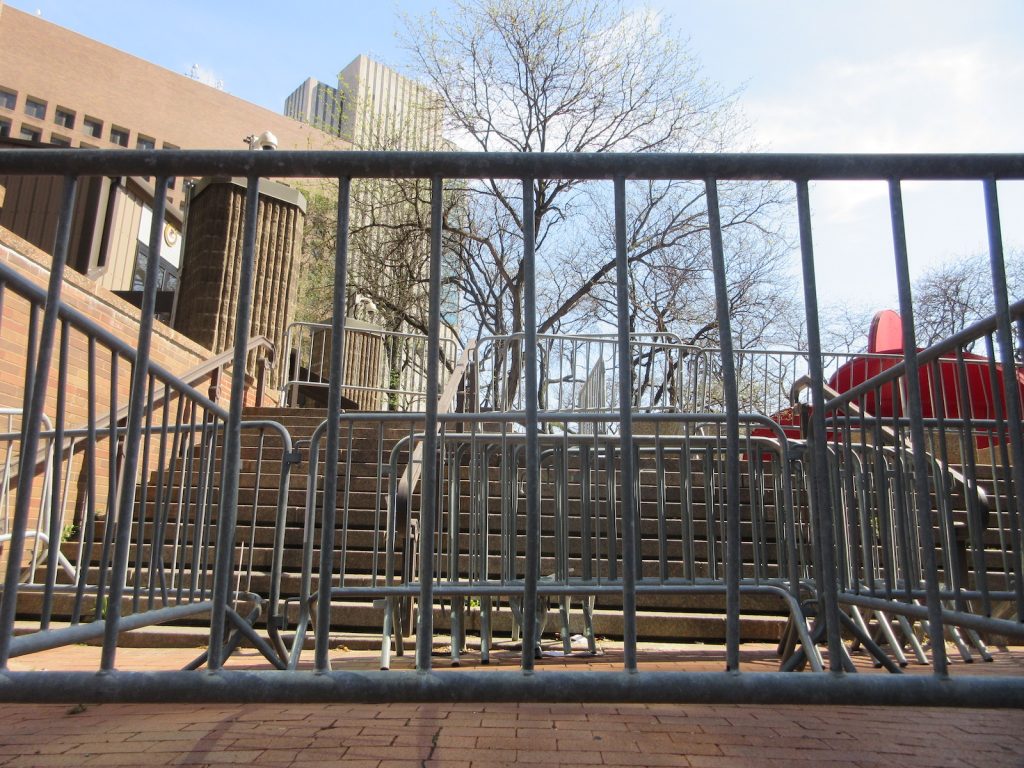
Mirabella has watched Chinatown and Little Italy change throughout his lifetime — his grandfather owned a butcher shop at 40 Mulberry Street, Nona and Canavari — which closed in the 1960s.
“No security, no barricades, no physical presence of police,” he recalled. “In fact, what I remember, we had community policing in Chinatown where there was an officer assigned to a beat. There was never any crime, we never had any problems,” he said of the area’s pre-9/11 conditions.
“I’ve never seen police who are so unfriendly,” he added, referring to the officers currently stationed at the checkpoints. “I approached one [of them] one time just to say hello. They tell me, ‘Get away from me. You can’t be near me! You might be armed.’ I said, ‘Come on, I’m 77 years old, you can see that I’m not threatening to you.’ ‘Oh we’re not allowed to talk to anybody,’ he said.”
Victoria Lee, who has lived in Chinatown for the past 10 years, has fond memories of walking through Park Row as a teenager, on the way to visit her late grandmother toward the end of her life at New York University Presbyterian Hospital in the Financial District, just two blocks south of the Brooklyn Bridge.
“She would always crave egg tarts and hot milk tea,” Lee said. “So whenever I needed to visit her in the hospital, I would get it very specifically from the bakery by her [apartment at Eldridge and Delancey Streets] called Lucky King,” she recalled, remembering how interconnected Chinatown and the rest of Lower Manhattan seemed at the time.
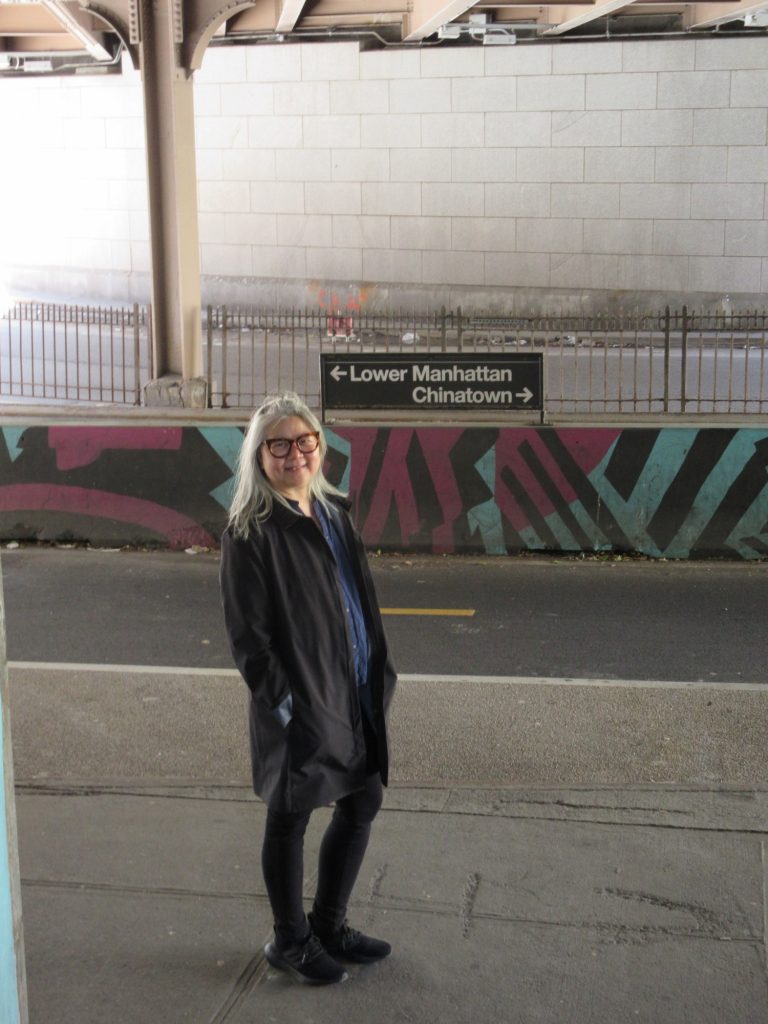
Lee is the co-founder of Welcome to Chinatown, a nonprofit dedicated to supporting the neighborhood’s small businesses. She said that, since most Chinatown businesses are known for their low prices and survive on slim profit margins, they rely on a high quantity of foot traffic to stay afloat — something they could get more readily if tourists were redirected from the Brooklyn Bridge into the neighborhood.
Upon exiting the Brooklyn Bridge on the Manhattan side, tourists and others are greeted by a small, unassuming sign reading “Chinatown,” virtually plastered over by graffiti. The infamous, so-called “Urine Staircase” that leads down to Park Row reeks of the smelliest subway station on the hottest summer day.
While it’s only a five-minute walk from there to Chinatown, one wouldn’t know it by the perplexing view they are confronted with: an empty street to nowhere strewn with parked police cars. Underneath the bridge, the once lively 4-acre Brooklyn Banks park, complete with trees, benches and a basketball court — and a favorite of skateboarders — is also completely closed off.
“This is not the way we should be treating one of the most historically and culturally significant places for Asian Americans in the U.S.,” Lee said.
Park Row’s closure has also been felt acutely by NYCHA residents in the nearby Smith Houses. Due to Park Row’s geography, the entire area serves as one massive roadblock to residents coming to and from the subway stations at City Hall.
On the Smith Houses’ other side, the Brooklyn Bridge serves as a divider reminiscent of Robert Moses’ infamous urban planning, keeping the community divided from the South Street Seaport and Financial District to the south.
Aixa Torres, a lifelong resident and tenant association president of Smith Houses, said that some nights, without explanation, the only direct street, Avenue of the Finest, leading from her complex to the 4, 5 and 6 trains is completely blocked off starting at 6 p.m., forcing residents to take a circuitous path home.
“N.Y.P.D. is the worst neighbors you can ever have,” she said. “I told the previous commissioner that to his face.”
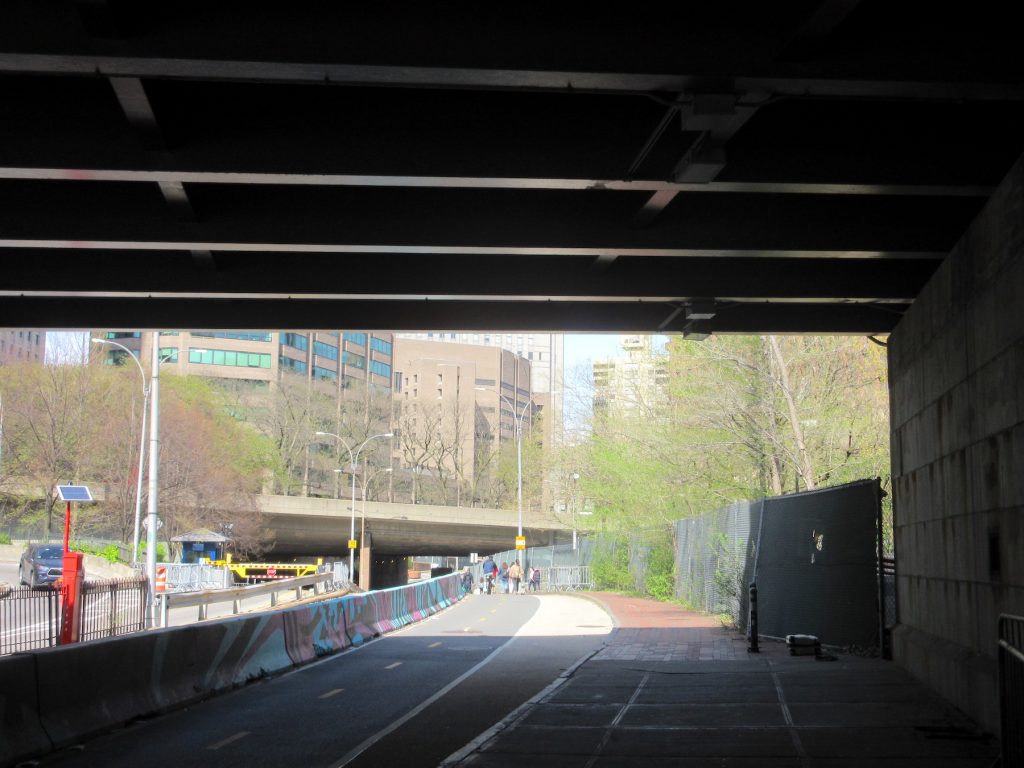
Even when the walkway is open at night, Torres said, “the lighting is so bad and with all the things going on now, even people’s lives are being endangered because you can’t even see where the hell you’re going.”
She’s also concerned that police vehicles have taken up all the surrounding streets, previously used by public housing residents, for placard parking.
“The N.Y.P.D. does not discuss security deployments,” said a spokesperson for the Deputy Commissioner for Public Information, the Police Department’s press department, in response to multiple e-mails from The Village Sun.
In 2003 and 2005, a group called the Civic Center Residents Coalition sued the Police Department, forcing it to produce an environmental impact statement assessing the effects of the area’s closure. In 2007, the agency’s report found no adverse impact from Park Row’s closure on either small businesses or residents.
The report justifies Park Row and the Civic Center’s closure, referred to as the “One Police Plaza Security Plan,” as necessary “to prevent the possibility of a vehicle bomb attack on N.Y.P.D. Headquarters.”
Jan Lee, a lifelong Chinatown resident, was a petitioner in the 2005 court case.
“What we found out was that very few businesses and very few residents were actually surveyed,” he said of the environmental report. “And so it was important to do it just to show that the city was acting not in good faith.”
A year later, in 2008, the city’s Department of Transportation under Mayor Bloomberg proposed the Chatham Square/Park Row Improvement Program. The plan would have beautified the closed-off streets by adding trees and vegetation, and creating new pedestrian plazas, offering a more appealing throughway for residents and tourists alike.
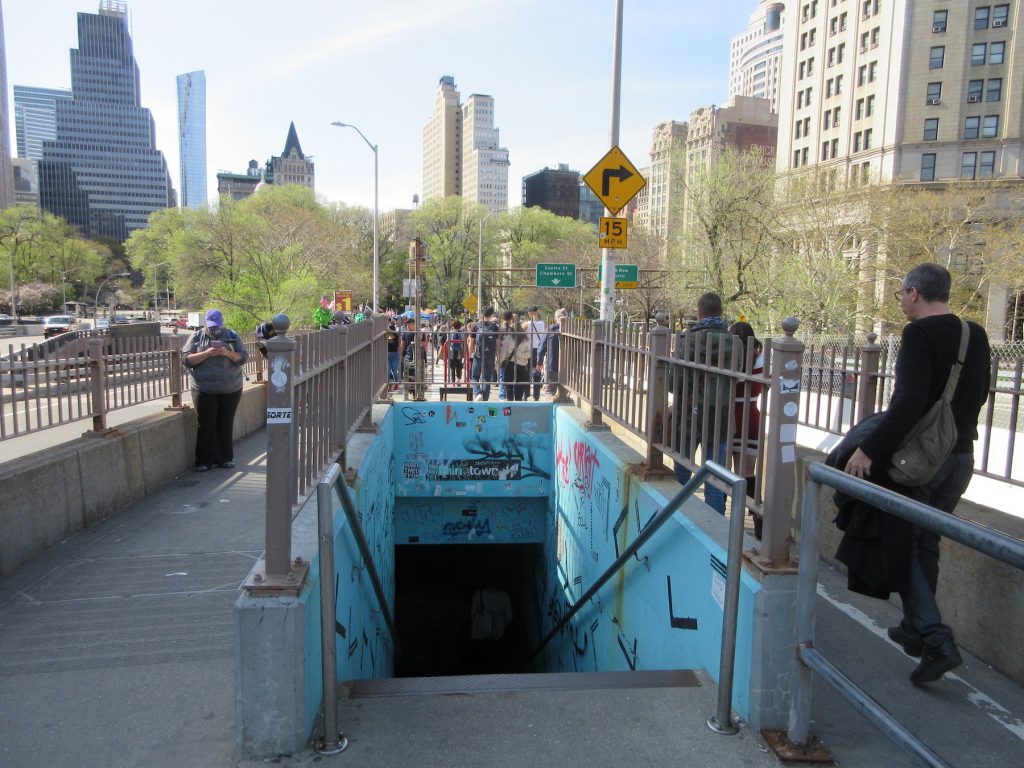
But the scheme was scrapped the next year due to community opposition, according to D.O.T. spokesman Vin Barone, who referred further comment on Park Row to the N.Y.P.D.
“We rejected that plan because it would permanently ensure that Park Row would never, ever open again,” Jan Lee said, stressing that any plan for the street should involve opening it up to car traffic.
“I think the threats of terrorism are not the same as they were in the year after 9/11,” he said. “And if the police are that much of a threat, we need to move the police out of this neighborhood.”
Others in the community disagree slightly, and would like to reach a compromise.
“If it indeed needs to remain closed for vehicular traffic, at least soften it, beautify it, landscape it, create some memorable experience that can be exciting,” said Wellington Chen, president of the Chinatown Business Improvement District.
“The Chinese believe in qi, which means ‘energy and flow,’” he said. “We are interrelated to one another. When the qi is disconnected, it’s not as well circulated as it should be.”
Chen said he would like to “enhance the reconnection” that’s been lost through the closure, “so that the healthy blood circulation can occur again, at least on the pedestrian level.”
Chinatown has been hit particularly hard since the start of the pandemic. Last year, anti-Asian hate crimes were up 361 percent citywide. More recently, the brutal murder of Cristina Yuna Lee in her apartment at Grand and Chrystie Streets put the entire neighborhood on high alert.
“If you walk through Chinatown anytime after 6 or 7, you see a lot of businesses get closed early, due to COVID and also due to crime,” said Raymond Tsang, president of the Chinese Consolidated Benevolent Association. “People just close early because they’re afraid and we don’t get enough tourists in the area for the businesses to remain open later,” he added.
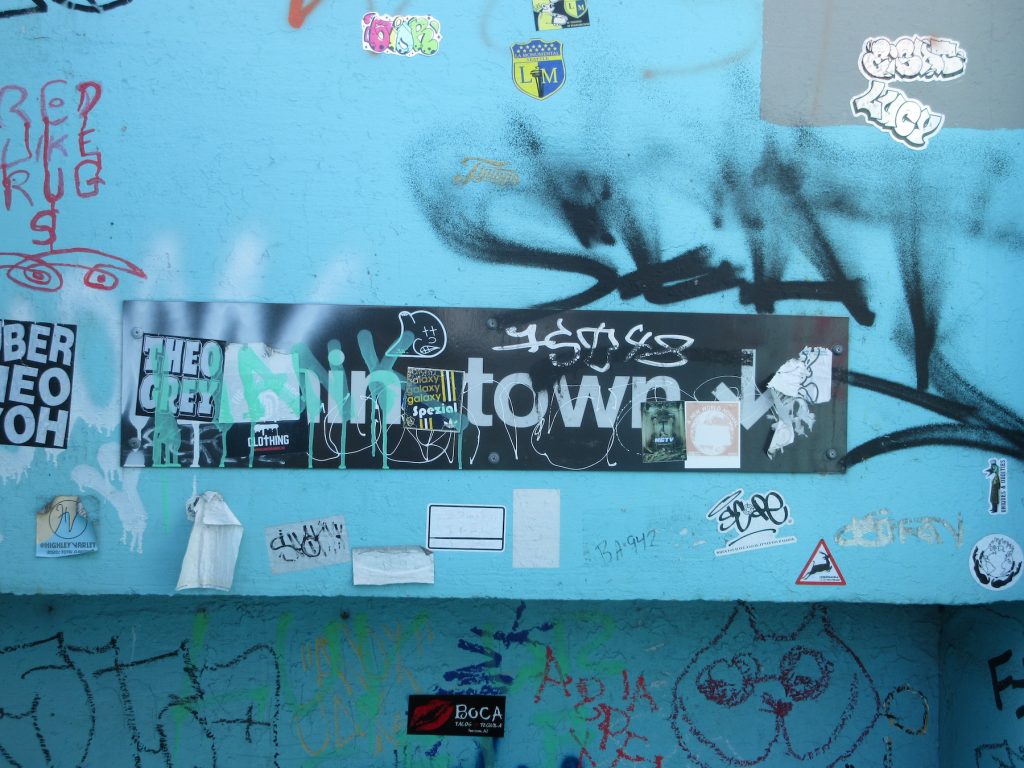
Those compounding factors only add to the need to revitalize or open up Park Row for many in the community.
“We need to start instilling hope,” Chen said.
In 2018 the city took a step in that direction by installing a two-way bike lane, only to see one of the two lanes shut off a few years later when the police updated their checkpoint configuration. And parts of that plan, like permanently installing a vendor at the foot of the bridge and redesigning the “Urine Staircase,” apparently never came to fruition.
“The N.Y.P.D. continues to use Park Row and the surrounding area as their campus,” said Nicholas Stabile, the other co-founder of Park Row Alliance, and a resident of Chathem Green since 2016. He said that, even when the bike lane was installed, few in the community were consulted.
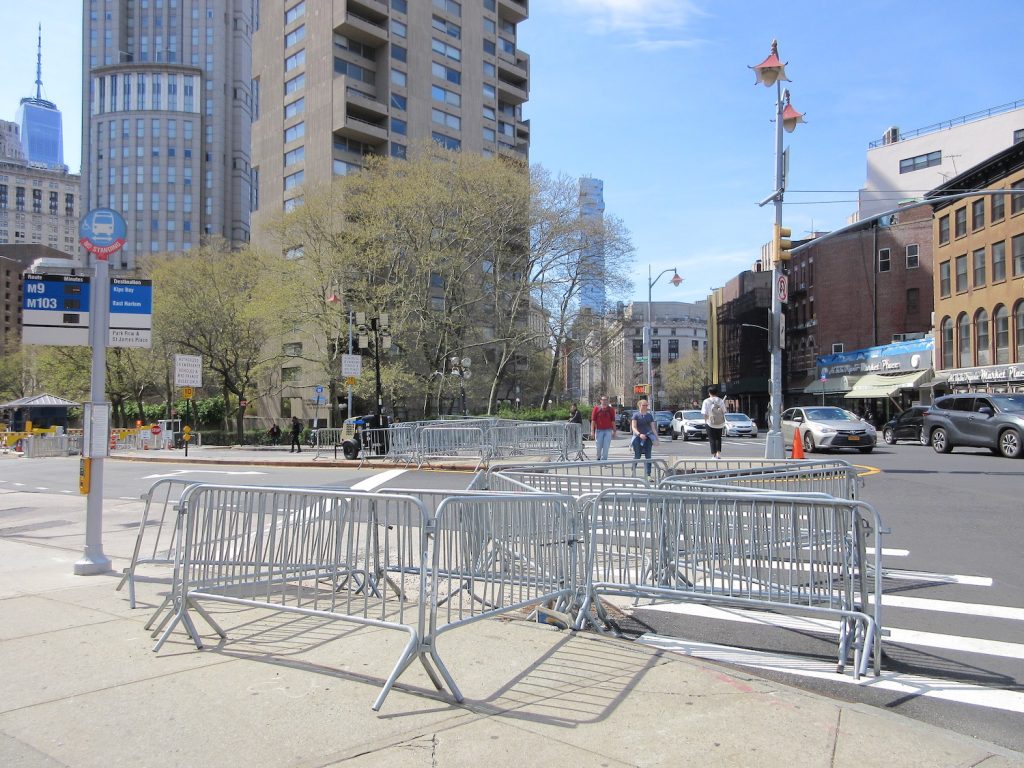
“What we truly need is a collaborative decision-making process that occurs between the N.Y.P.D., D.O.T., the local councilmember and the local community,” he added. “Councilmember [Margaret] Chin was utterly disappointing.”
Now, more than 20 years after the street — and, thus, the surrounding area — was shut down, some residents believe they have cause for hope.
In late fall 2021, Governor Kathy Hochul announced a $20 million investment in Chinatown, referred to as the Chinatown Downtown Revitalization Initiative (D.R.I). The aim of the funding is to “capitalize on recent public and private investments in resiliency, placemaking and neighborhood infrastructure to build and strengthen the community’s cultural anchors, increase growth and resiliency of small businesses, and improve connectivity to surrounding communities.”
Park Row Alliance co-founder Kong submitted a proposal to the D.R.I. that involves creating murals, plus installing lights and wayfinding signage, starting with the Brooklyn Bridge staircase. It’s essentially a scaled-back version of the 2008 plan — some version of which she hopes to see implemented in full in the future.
Torres called the D.R.I. “the one project that I’m 1,000 percent for.”
She serves on the D.R.I. committee, which will make a final recommendation to the governor’s office in July.
“There’s a potential opportunity for the mayor and the governor to really invest in this community, not with jails, not with homeless shelters, but actually invest in this project,” Kong stressed.

As for the Brooklyn Bridge Banks, the community might have to wait a little longer.
“The area informally known as the ‘Brooklyn Banks’ has been closed to facilitate essential repairs to the Brooklyn Bridge,” said D.O.T. spokesperson Barone in a statement to The Village Sun. “D.O.T. is aware of community requests to open and upgrade areas around and under the bridge, and is currently exploring concepts that may be possible once construction ends in 2024.”
“Reopening Park Row is a puzzle that no politician has previously had the will to solve,” said Councilmember Christopher Marte, who entered office in January. “But it’s a high-traffic area for residents, pedestrians, cyclists and public transit, and just because it’s complicated doesn’t mean it’s impossible to fix.
“It’s not going to be a quick transformation, because decades of disinterest and disinvestment have led to the current system where N.Y.P.D. sees no reason to give up their space, and layer after layer of bureaucracy has to approve any changes,” Marte said. “But I feel optimistic about the work we’ve done so far, and all that’s still ahead of us.”

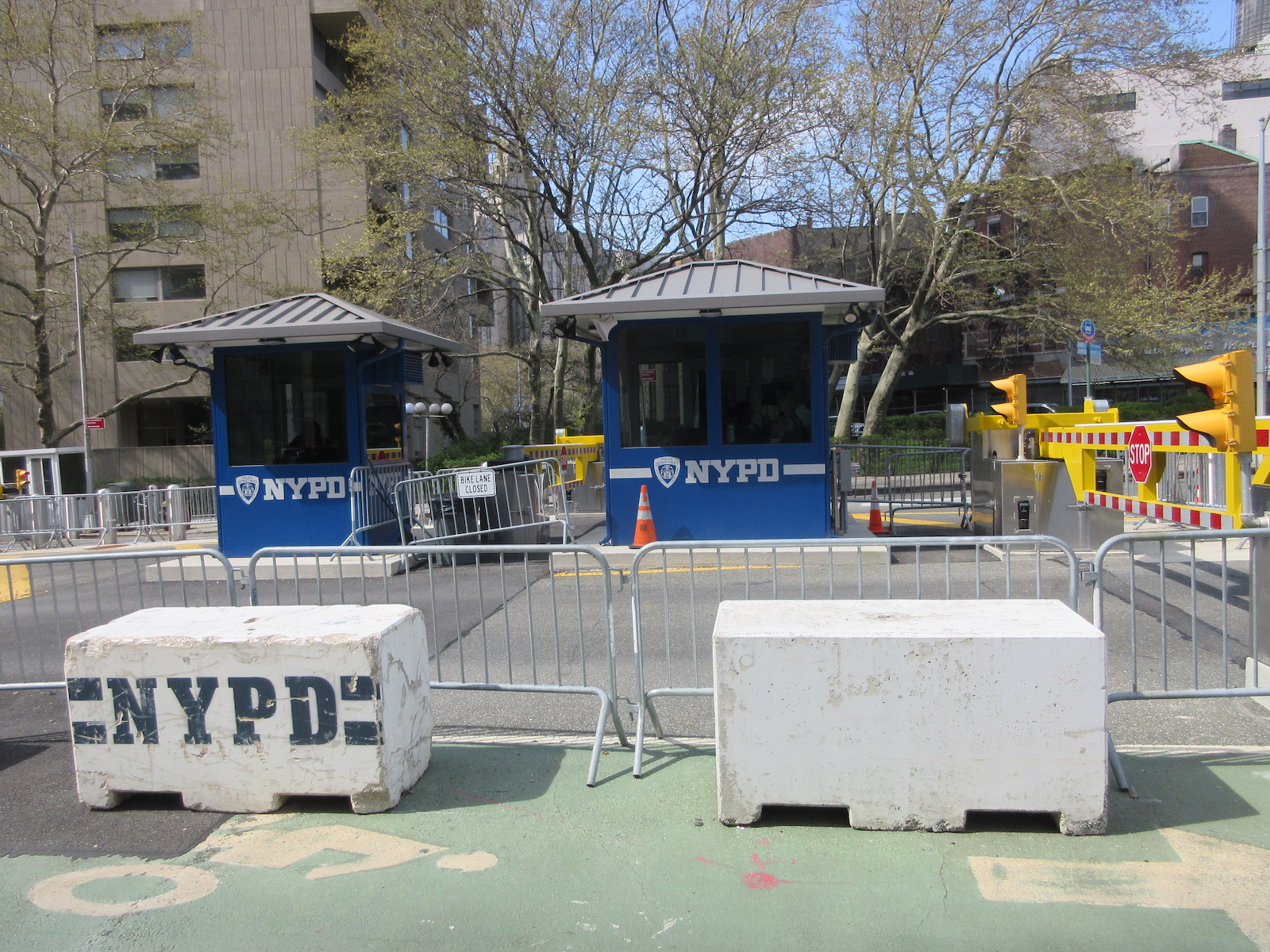
Hire a landscape architect from Columbia’s School of Architecture and HPD or City Planning, work with Hochul and Adams’s Parks team and get it done. Get private funding from Bloomberg?
I agree, police stay inside their buildings. They do not have a much-needed presence on the streets anymore.
It’s a shame this area is neglected. Make it beautiful, like Bloomberg and de Blasio’s hometowns of Boston. (Medford and Cambridge respectively). Much prettier than this area.
Love the idea of taking back this space from the NYPD after they stole it for 20+ years. But why the push to give it right back to cars? It’s been car-free for 20+ years. Why not fight to make as much of it green space as possible? It would have such potential as a walking/biking/bus connection to the lower tip of Manhattan, while providing new green space for the surrounding community, which is so rare.
You know someone isn’t too bright when they claim the NYPD “stole” it. Did they sell it or build high-rise luxury condos? Your progressive Democratic leaders made these decisions. The billion-dollar waste that is the borough-based jails. Closing large swaths of land. Shutting down Rikers Island for some silly green energy project that won’t accomplish much of anything. Vote accordingly or stop complaining.